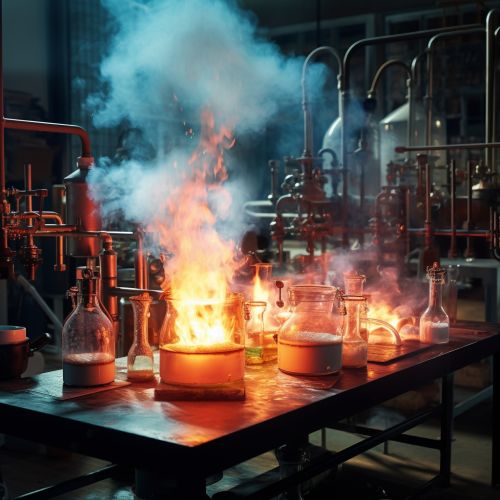Exothermic Process
Introduction
An exothermic process is a type of thermodynamic process in which energy, in the form of heat, is released into the surrounding environment. This is in contrast to an endothermic process, where energy is absorbed from the surroundings in the form of heat. The concept of exothermic processes is fundamental to the study of physical chemistry, thermodynamics, and chemical engineering.


Energy Transfer in Exothermic Processes
In an exothermic process, the system loses energy to the surroundings. This energy transfer can occur in various forms, such as heat, light, or sound. However, the most common form is heat. The energy transfer is due to the difference in energy between the reactants and the products of a chemical reaction. If the total energy of the products is less than the total energy of the reactants, the excess energy is released, usually in the form of heat, making the process exothermic.
Examples of Exothermic Processes
Exothermic processes are common in nature and in many scientific and industrial applications. Some examples include:
- Combustion: The process of combustion is a classic example of an exothermic reaction. When a substance burns, it reacts with oxygen to produce heat and light. This is the principle behind the operation of engines, heaters, and fireworks.
- Respiration: In biological systems, cellular respiration is an exothermic process. Organisms break down glucose and other nutrients to produce energy, releasing heat as a byproduct.
- Neutralization: In a neutralization reaction, an acid reacts with a base to form water and a salt, releasing heat in the process.
- Crystallization: The formation of a crystal from a solution or a melt is an exothermic process. As the particles come together to form the ordered structure of a crystal, energy is released.
Thermodynamics of Exothermic Processes
From a thermodynamic perspective, exothermic processes are characterized by a negative change in enthalpy (ΔH). Enthalpy is a measure of the total energy of a thermodynamic system. It includes the internal energy of the system and the energy required to make room for it by displacing its environment. A negative ΔH means that the system is losing energy, which is characteristic of exothermic processes.
Exothermic processes are also associated with an increase in entropy (ΔS), or disorder, of the universe. The second law of thermodynamics states that the total entropy of the universe must increase for a process to be spontaneous. Since exothermic processes release heat into the surroundings, they tend to increase the entropy of the universe, making them spontaneous under certain conditions.
Measurement of Exothermic Processes
The energy released in an exothermic process can be measured using a device called a calorimeter. This device measures the heat of reaction or physical changes and heat capacity. The heat released by the exothermic process raises the temperature of the surroundings, which can be measured to calculate the amount of energy released.
Industrial Applications of Exothermic Processes
Exothermic processes have many industrial applications. They are used in energy production, such as in combustion engines and nuclear reactors. They are also used in the production of chemicals, such as in the Haber process for the production of ammonia. In addition, they are used in materials processing, such as in the hardening of steel.
Environmental Impact of Exothermic Processes
While exothermic processes are essential for many aspects of modern life, they also have environmental impacts. The combustion of fossil fuels, for example, releases heat and greenhouse gases into the atmosphere, contributing to global warming. Similarly, some industrial exothermic processes release pollutants into the environment.
